Unpretentious tasty variety of honeysuckle "Amphora"
Honeysuckle, a plant common in East Asia and many northern countries, is becoming increasingly popular among Russian gardeners due to its decorative value, as well as its tasty and healthy berries. You will learn about the qualities of Amphora honeysuckle, as well as the rules for growing this unpretentious edible crop variety with delicious fruits in the article.
Description of the honeysuckle variety Amphora
Gardeners who have chosen Amphora for growing on their plots leave the best reviews about the variety: they praise it for its original taste, resistance to disease and cold, and ease of care.
Origin, development and history of breeding
The basis for breeding the culture was wild honeysuckle, which grows naturally on the Kamchatka Peninsula.
Reference. Amphora was first obtained in the 90s of the twentieth century in St. Petersburg at the Pavlovsk experimental station of the All-Russian Institute of Plant Genetic Resources named after Academician N.I. Vavilov as a result of free pollination of cultivated varieties Roxana wild growing Honeysuckle Kamchatka.
In 1998, the newly bred variety was included in the State Register of the Russian Federation as an achievement in the field of breeding, was recommended for cultivation in cold regions of the country and gained recognition among gardeners for its unpretentiousness and excellent taste of berries.
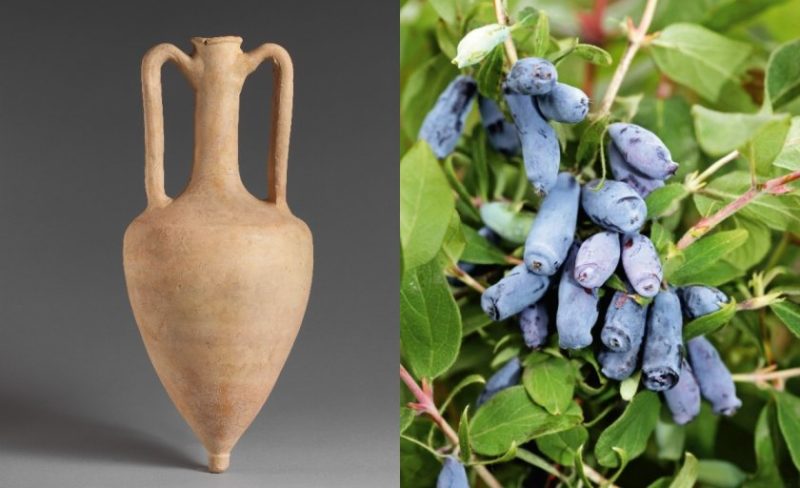
Characteristics, description of appearance, taste
Honeysuckle Amphora is a perennial shrub, classified as a medium-sized crop by its growth type.Branches directed upward at a slight slope with reddish-brown bark and slightly pubescent green lanceolate leaves form a neat rounded crown. The height of mature plants is 1.4-1.5 m, and the diameter is 1 m.
Amphora blooms with small, bell-like flowers of a greenish-yellowish color.
The variety got its name thanks to its elegant large oblong fruits, shaped like small jugs. The length of the berries, covered with a durable, smooth blue-blue skin with a waxy coating, reaches up to 2 cm, and one piece weighs on average from 0.8 to 1.2 g, although there are also three-gram specimens.
The dense pulp of the fruit is odorless, but has a pleasant taste and contains a large amount of vitamins (A, C, group B) and microelements (iodine, silicon, sodium, zinc, copper and others), which are preserved by:
- freezing;
- heat treatment;
- long-term storage.
Sweet and sour berries with a barely noticeable bitterness leave a lingonberry aftertaste and received a specialist rating of 4.5 out of 5 for their high taste.
Features of the use of this variety
The honeysuckle variety belongs to the dessert variety, but at the same time the shrub has high decorative qualities, and its lush crown will serve as a worthy decoration for a summer cottage or garden area.
The fruits are eaten both fresh and processed:
- compotes;
- jams;
- juices;
- jam;
- fruit drink.
The berries have a number of medicinal properties:
- anti-inflammatory;
- disinfectants;
- choleretic;
- diuretics;
- general strengthening.
Productivity and fruiting
The first harvest of a fast-growing crop is harvested in the third year after the spring planting of annual bushes in a permanent place.
Attention! Experienced gardeners recommend autumn planting of the two-year-old honeysuckle shrub Amphora. In this case, the crop will bear fruit the next year.
Average collected from one bush from 600 g to 1.1 kg of fruit, however, depending on growing conditions, this amount can be much larger - from 1.7 to 2 kg.
With proper care, the bush successfully bears fruit for 20-30 years.
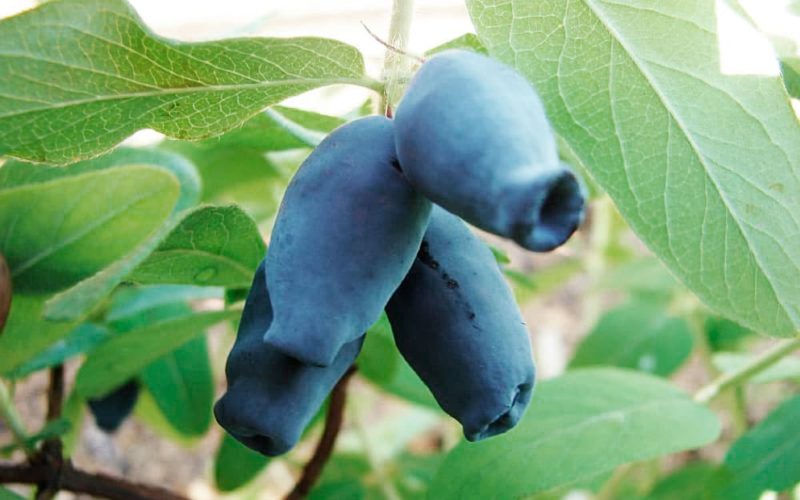
Ripening period
Honeysuckle Amphora is a mid-late variety.
The berries become ripe almost simultaneously. Ripening comes between mid and late June.
Resistance to diseases and pests
Amphora is characterized by high disease resistance and resistance to pest damage, however, the plant may suffer from:
- fungal diseases;
- aphid attacks, scale insects, honeysuckle.
Resistance to cold and drought
The crop tolerates return frosts without problems and has increased frost resistance:
- buds can withstand temperatures up to – 47°C;
- flowers cannot be damaged by spring frosts down to -7°C.
The plant also tolerates drought quite steadfastly, but in dry weather it requires additional watering.
For which regions is it best suited and what are the climate requirements?
The variety is cultivated in all regions of the Russian Federation, but the most favorable climatic conditions for Amphora are:
- Middle zone;
- Ural;
- Siberia;
- Altai;
- Far East.
The crop grows especially well in central Russia, where there are no sudden temperature changes and the weather is relatively stable.
Although honeysuckle is not particularly demanding on the climate, it is unfavorable for obtaining good harvests:
- very coldy;
- the weather is too hot and dry.
The main advantages and disadvantages of the variety
Amphora honeysuckle has much more advantages than disadvantages.
The advantages of the variety include:
- large fruit;
- versatility of berries;
- decorative appearance of the bush;
- excellent taste and high commercial characteristics of the fruit - the berries tolerate transportation well, while maintaining a good appearance and without losing their beneficial properties;
- cold resistance - the plant has increased resistance to spring frosts and winter cold;
- ability to resist diseases and insect pests;
- lack of secondary flowering;
- ease of care when growing;
- almost simultaneous ripening of fruits, which can remain on the branches without falling for a long time (up to 14 days in the absence of strong winds);
- the ability to transplant bushes to another place without negative consequences for the plant.
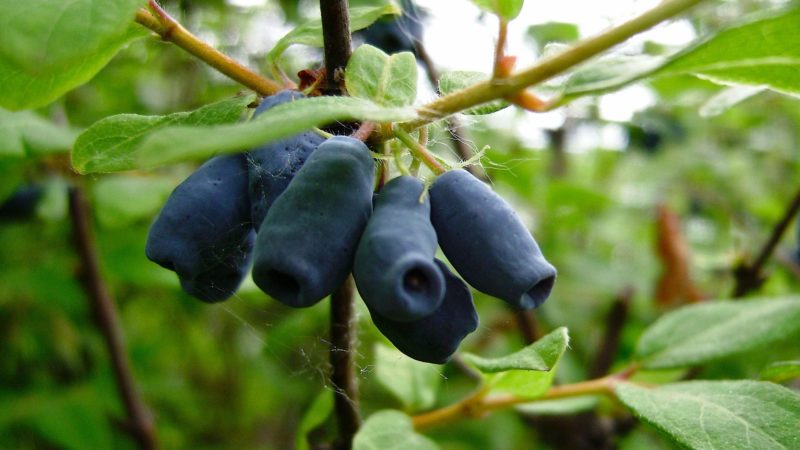
Among the disadvantages, it is first of all worth noting the self-sterility of the variety.
Important! For successful fruiting of the crop, it is necessary to plant at least one different variety of honeysuckle near the Amphora bush.
Other disadvantages concern shrubs growing in constant shade:
- their fruits lose their taste and become very sour;
- the ovary may not appear at all.
What is the difference from other varieties and hybrids
Amphora honeysuckle does not have the problem of secondary flowering that many other varieties have, which makes them difficult to grow in southern regions.
This occurs due to an early dormant period, which ends with autumn flowering and further freezing of the buds in winter, after which, with the onset of spring, the bushes practically do not bloom and do not produce a good harvest.
The variety also compares favorably with other representatives of honeysuckle:
- large size and original taste of berries;
- high productivity;
- winter hardiness;
- increased resistance to diseases and pests;
- the fact that the fruits do not fall off the branches for a long time and do not spoil.
Agricultural technology
The crop is perfect for growing in open ground and does not require too much care, however, to get a good harvest, the rules of agricultural technology should not be neglected.
Choosing a place in the garden and preparing holes
For planting shrubs in a permanent place choose a site:
- well lit by the sun (light partial shade is acceptable);
- protected from drafts and strong gusty winds.
Reference. Amphora can also be grown in the shade if the area is sufficiently ventilated, but in this case it will not be possible to harvest a good harvest of full-fledged fruits.
Although the culture is quite moisture-loving, the planting site should not be chosen in a lowland, where the following may occur:
- waterlogging of the soil due to the proximity of groundwater;
- swampy soil;
- accumulation of melt or sediment water.
Favorable neighbors for honeysuckle:
- Apple tree;
- jasmine;
- lilac.
Holes for planting shrubs are dug measuring 400 cm x 400 cm x 400 cm at a distance of 1.5-2 m from each other.
2-3 weeks before planting seedlings, place in each hole:
- 10 cm layer of drainage (crushed stone or broken brick);
- 1 bucket of compost;
- 150 g superphosphate;
- 1 liter of wood ash;
- 60 g potassium sulfate;
- a little sand.
The entire composition is carefully mixed.
Preparing for landing
To ensure that the bushes take root well, 2-3-year-old trees with a well-developed root system and a crown diameter of at least 20 cm are taken for planting in a permanent place.
Before boarding:
- the roots of the seedlings are kept in water for 2 hours;
- then sprinkled with ash or treated with a weak solution of potassium permanganate.
Soil requirements
Suitable for growing crops light fertile soils with good breathability and neutral or slightly acidic reaction.
If the soil is highly acidic, add a deoxidizing agent to the hole:
- chalk;
- ash;
- dolomite flour;
- lime.
The groundwater level should not be less than one and a half meters.
Dates, scheme and rules of planting
The crop is planted in a permanent place at different times, depending on the region.
Attention! For Amphora honeysuckle, the growing season begins early. Already in March, the plant begins to emerge from dormancy, and in May - June its active life activity occurs.
That's why plant shrubs:
- in the southern regions (where the snow melts no later than mid-March) - in the spring, in April, when the weather has stabilized, but the buds have not yet begun to actively develop, or in the fall, September to November, when the active life of the plant has ceased, but there are no frosts yet;
- in the central regions - from September to the first half of October;
- in the north - from August to September.
2-3 buckets of warm water are poured into the prepared holes, spaced 1.5-2 m from each other and filled with nutritious soil mixture, after which:
- An elevation is formed in the center of each hole.
- A peg is installed in the middle.
- The seedling is placed on a mound, carefully straightening the roots.
- The root collar is buried 3 cm.
- Cover with soil.
- The soil surface is compacted.
- Pour 1-2 buckets of water under the bush.
- A layer of mulch is placed on the tree trunk circle using humus, sawdust, compost, and peat.
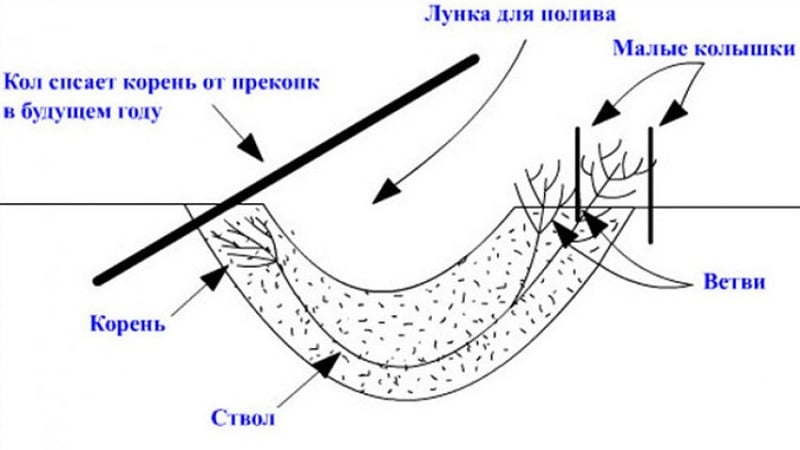
Features of cultivation
Caring for Amphora includes basic agrotechnical measures:
- Watering during the flowering period, during the formation of ovaries and before the start of fruiting (in the southern regions - every other day, during the dry period - daily in the morning and evening by sprinkling, using a dispersed nozzle).
- Loosening. The procedure is especially relevant in the spring, when it is necessary to ensure good access of oxygen to the roots.
- Weeding so that weeds do not weaken the bush.
- Pruning to increase productivity and make the bushes more decorative.
- Application of organic and mineral fertilizers to the soil with the onset of fruiting age.
- Mulch the soil with mullein or compost.
Attention! To prevent the soil from sticking together when watering, make a furrow 10-15 cm deep and pour water into it.
Nuances of care
For the first 2-3 years, the bush is pruned exclusively for sanitary purposes, removing damaged branches and branches growing inside the crown. Pruning to thin out the crown and give it the desired shape is done after the plant reaches 4-6 years old, and this is done in spring or autumn, in September - October, when there is no longer any foliage and the branches are clearly visible.
Old shoots are removed at the age of 8 years, and when they reach 15 years old, they are cut to half the bush, after which the plant is fed generously.
Important! Under no circumstances should you prune Amphora honeysuckle bushes immediately after autumn planting - the procedure will weaken the plant and negatively affect its further development and fruiting. In spring, shoots are shortened by 30 cm.
As the shrub matures, the loosening procedure is carried out with extreme caution so as not to harm the overgrown root system.
The plant is watered not only during the growing season, but also after picking the fruits (in July - August) to ensure a good harvest in the new season.
Fertilizing is especially important from the moment the bush begins to form its first fruits:
- before flowering and the appearance of ovaries, the soil is enriched with mullein infusion (1 kg per bucket of water);
- at the end of summer, add a composition of 0.5 liters of wood ash and 10 liters of water;
- in the spring they feed culture with urea solution (20 g per bucket of water);
- after picking the berries - with a composition of 20 g of ammonium nitrate, 60 g of superphosphate and 10 g of urea per 10 liters of water;
- in August - 20 g of potassium sulfate and 60 g of superphosphate per bucket of water.
Pollinators
A self-sterile plant needs cross pollination. To ensure this, next to the bush, at a distance of 2 m, other varieties of honeysuckle are planted in a group, the flowering time of which is the same as that of Amphora - 2, 3 or more bushes.
Best suited as pollinators:
- Altair;
- Nymph;
- Gzhelka;
- Moraine;
- Pavlovskaya;
- Viola;
- Violet;
- Azure.
Disease and pest control
In summer, with frequent heavy rainfall, the plant can be affected by fungal diseases:
- rust;
- penosporosis.
To protect against diseases, the plant is treated with:
- in spring - 5% urea solution or 2% Actellica;
- after picking berries, use fungicidal preparations “Topaz”, “Skor”, “Flint”.
Reference. Spraying Amphora honeysuckle with Zircon and Epin is a reliable way to protect the bush from fungal attack.
Aphids sometimes appear on young shoots of the plant, which they fight with the help of hot pepper tincture.
Scale insects and fingerwings are destroyed with organic preparations so as not to harm the fruits:
- "Gamair";
- "Fitosporin".
Preparing for winter
Winter-hardy variety for the onset of cold weather easy to prepare:
- in November, carry out abundant watering;
- the tree trunk circle is mulched with sawdust, fallen leaves, and compost;
- add fallen snow to the bush;
- the trunks of the branches are covered with whitewash;
- install a protective metal mesh.
Attention! Young Amphora honeysuckle bushes are covered for the winter with agrofibre, spruce branches or burlap.
Reproduction
The culture is propagated in three ways:
- Rooting cuttings, harvesting them in the fall, rooting them in the winter and planting them in a permanent place in the spring.
- By dividing the bush, in autumn or spring, evenly dividing the bushes using a sharp shovel.
- By layering: one of the lower branches is buried 10 cm into a groove dug in the ground, secured, watered regularly, and when young shoots appear, they are transplanted.
Harvesting
Due to the fact that Amphora honeysuckle berries ripen evenly and can remain on the branches for a long time without falling off, harvesting is quite quick and easy.
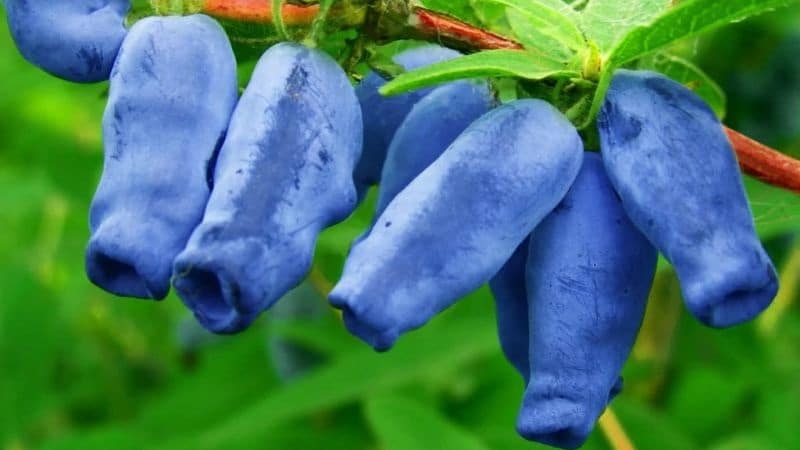
How and when to collect
The fruits are harvested in the second half of June, starting in the middle of the month.
Reference. The harvested Amphora honeysuckle can be stored in the refrigerator for a week.
What difficulties may there be when growing
Experts identify three main problems:
- After the shoots reach 5 years of age, the yield of the bush may decrease. To avoid the problem, you need to carry out anti-aging pruning once every 2-3 years, replacing old branches with young ones.
- If the plant does not bear fruit or there are very few berries, you need to make sure there is a sufficient number of suitable pollinators, and also spray the bush with a sugar solution (2 tbsp.per bucket of water) to attract insects during the flowering period.
- The crop may be damaged by bird infestation. To protect against birds, use a metal mesh or install a scarecrow.
Tips and reviews from experienced gardeners about the variety
Olga, Barnaul: “Very pleased with the variety. Honeysuckle Amphora perfectly withstands cold weather and is characterized by stable fruiting. Ripe berries practically do not fall off. Despite the fact that the plant is resistant to pests and diseases, I recommend spraying the bushes with special preparations for prevention.”.
Evgeniy, Mr. Kaliningrad: “I read reviews about Amphora honeysuckle and decided to try growing it on my site. I am satisfied with the result. The variety is really unpretentious, does without shelter for the winter, and bears fruit consistently. I try to water the bushes regularly, apply fertilizing in a timely manner, and I advise everyone who chooses this variety to grow to do the same. This type of care can significantly increase productivity.”.
Results
A careful study of the characteristics of Amphora honeysuckle, compliance with the rules of planting shrubs and proper care of the plant will ensure an annual stable harvest of fruits of excellent quality, the benefits of which for the human body cannot be overestimated.